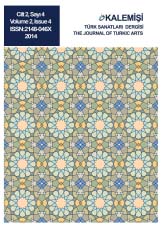Çini Sanatı ve Terminolojisi Üzerine
ABOUT CHINA ART AND ITS TERMINOLOGY
Author(s): Mezahir Ertuğ Avşar, Lale AvşarSubject(s): Museology & Heritage Studies, Customs / Folklore, Architecture, Visual Arts
Published by: Sanat ve Dil Araştırmaları Enstitüsü
Keywords: Art of tile-making; terminology; architectural ceramics; Anatolian art;
Summary/Abstract: The word china (faience) appearing firstly in the Ottoman Palace has revealed the new approach defining ceramic products turning into evani (pots and pans) and kaşı (glazed tile) depending on the body characteristics and on the usage aim in Islamic World. In fact, this definition being only towards siliceous body has made china ceramics, which have found great approval in Anatolia, apparent among others and gave them a special and privileged position. That today the perception way and education of tile-making art in Turkish society is carried out in Traditional Arts, not in Ceramics departments, should be the continuation and outcome of the relevant approach. As time goes on, various domain experts using the word china have widened the meaning range of this word and gave it new meanings. While today all architecture is defined as ceramic tiles by art historians, ceramists generally use the term for siliceous clay and the china artisans use it for all architecture and usage goods ceramics made of this clay. Unfortunately, this terminology problem shows itself not only in the word china but also in many terms of this art. Another aspect of the problem is that the word china is peculiar to Anatolia and stated in various ways such as “tile”, “mural ceramics” and “faience” in foreign languages. In the declaration, the terminology of the tile-making will be examined in the example of the word china, and the contemporary usage and meaning attributions in different areas of science and art will be followed. The research will provide an apparent improvement on the way of forming the common ceramic tiles terminology and therefore offer opportunity for looking the event from wide historical angle and for being more objective in the future decisions.
Journal: Kalemişi - Türk Sanatları Dergisi
- Issue Year: 2/2014
- Issue No: 4
- Page Range: 1-13
- Page Count: 13
- Language: Turkish

